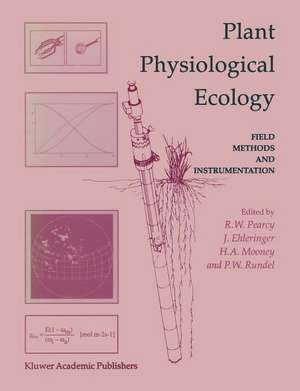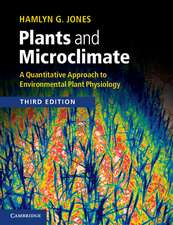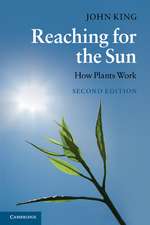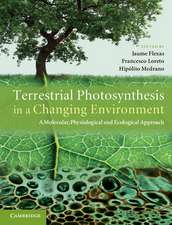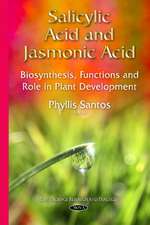Plant Physiological Ecology: Field methods and instrumentation
Editat de Robert W. Pearcy, J. R. Ehleringer, Harold Mooney, Philip W. Rundelen Limba Engleză Paperback – 31 oct 1990
Preț: 662.30 lei
Preț vechi: 779.17 lei
-15% Nou
Puncte Express: 993
Preț estimativ în valută:
126.77€ • 137.75$ • 106.56£
126.77€ • 137.75$ • 106.56£
Carte tipărită la comandă
Livrare economică 21 aprilie-05 mai
Preluare comenzi: 021 569.72.76
Specificații
ISBN-13: 9780412407307
ISBN-10: 0412407302
Pagini: 472
Ilustrații: 472 p. 16 illus.
Dimensiuni: 189 x 246 x 21 mm
Greutate: 1.03 kg
Ediția:2000
Editura: SPRINGER NETHERLANDS
Colecția Springer
Locul publicării:Dordrecht, Netherlands
ISBN-10: 0412407302
Pagini: 472
Ilustrații: 472 p. 16 illus.
Dimensiuni: 189 x 246 x 21 mm
Greutate: 1.03 kg
Ediția:2000
Editura: SPRINGER NETHERLANDS
Colecția Springer
Locul publicării:Dordrecht, Netherlands
Public țintă
ResearchCuprins
1 Principles of instrumentation for physiological ecology.- 1.1 Introduction.- 1.2 Measurement and measurement errors.- 1.3 Instrument organization.- 1.4 Instrument initiation.- 1.5 Postscript.- 2 Field data acquisition.- 2.1 Introduction.- 2.2 Analog recorders.- 2.3 Digital recorders.- 2.4 Integrators.- 2.5 Sampling considerations.- 3 Water in the environment.- 3.1 Soil moisture.- 3.2 Atmospheric moisture.- 3.3 Moisture flux.- 4 Measurement of wind speed near vegetation.- 4.1 Introduction.- 4.2 Flow in wind tunnels, growth cabinets and ducts.- 4.3 Weather stations and field survey.- 4.4 Wind profiles above vegetation.- 4.5 Boundary layer resistance.- 4.6 Calibration.- 4.7 Aerodynamic influence by masts.- 4.8 Visualization.- 4.9 Pressure measurements.- 4.10 Some applications.- 5 Soil nutrient availability.- 5.1 Introduction.- 5.2 Difficulties in measuring nutrient availability.- 5.3 Nitrogen availability.- 5.4 Phosphorus availability.- 5.5 Sulfur availability.- 5.6 Availability of essential cations.- 5.7 Micronutrient availability.- 5.8 Soil classification.- 5.9 Bioassay of nutrient availability.- 5.10 Soil acidity.- 5.11 Soil salinity.- 5.12 Soil redox potential.- 5.13 Comments on sampling.- 5.14 Index units.- 6 Radiation and light measurements.- 6.1 Introduction.- 6.2 Definitions and units.- 6.3 Energy versus photons as a measure of PAR.- 6.4 Radiation sensors: general characteristics.- 6.5 Determination of the diffuse and direct components of radiation.- 6.6 Calibration of radiation sensors.- 6.7 Sampling considerations.- 6.8 Photographic estimations of light climate.- 6.9 Spectral radiometry.- 7 Temperature and energy budgets.- 7.1 Introduction.- 7.2 Energy budget approach.- 7.3 Variations in air and leaf temperatures with height.- 7.4 Temperature and its measurement.- 7.5 Orientation and its measurement.- 7.6 Calculation of incident solar radiation on different surfaces.- 7.7 Leaf absorptance and its measurement.- 7.8 Boundary layer considerations.- 8 Measurement of transpiration and leaf conductance.- 8.1 Introduction.- 8.2 Leaf transpiration rate.- 8.3 Leaf conductance to water vapor.- 8.4 Instrumentation for transpiration measurements.- 8.5 Calibration of water vapor sensors.- 8.6 Systems for measuring transpiration and leaf conductance.- 8.7 Whole-plant measurements of transpiration.- 9 Plant water status, hydraulic resistance and capacitance.- 9.1 Introduction.- 9.2 Water potential and its components.- 9.3 Water content.- 9.4 Hydraulic resistance and capacitance.- 9.5 Conclusion.- 10 Approaches to studying nutrient uptake, use and loss in plants.- 10.1 Introduction.- 10.2 Nutrient uptake.- 10.3 Nutrient use and nutrient status.- 10.4 Chemical analysis.- 10.5 Nutrient loss.- 11 Photosynthesis: principles and field techniques.- 11.1 The system concept.- 11.2 Principles of photosynthesis measurement.- 11.3 Components of gas-exchange systems.- 11.4 Real photosynthesis systems.- 11.5 Matching instrument to objective.- 11.6 Calibrating photosynthesis systems.- 11.7 Calculating gas-exchange parameters.- 11.8 List of symbols.- 12 Crassulacean acid metabolism.- 12.1 Introduction.- 12.2 Measurement of succulence.- 12.3 Nocturnal acidification.- 12.4 Nocturnal CO2 fixation.- 12.5 Analysis of day-night and seasonal patterns of CO2 and H2O vapor exchange.- 12.6 Measurement of photosynthesis and respiration by O2 exchange.- 12.7 Water relations.- 12.8 Stress physiology.- 13 Stable isotopes.- 13.1 Introduction.- 13.2 Natural abundances of stable isotopes of ecological interest.- 13.3 Stable isotope mass spectrometry.- 13.4 Sample preparation.- 13.5 Sample variability.- 13.6 Application of stable isotopes in ecological studies.- 14 Canopy structure.- 14.1 Introduction.- 14.2 Direct methods.- 14.3 Semidirect methods.- 14.4 Indirect methods.- 14.5 Summary.- 15 Growth, carbon allocation and cost of plant tissues.- 15.1 Introduction.- 15.2 Growth analysis.- 15.3 Fate of carbon.- 15.4 Carbon and energy costs of growth and maintenance.- 16 Root systems.- 16.1 Introduction.- 16.2 Assessing root system structure and biomass in the field — determining what is there.- 16.3 Determination of root length and surface area.- 16.4 Microscale distributions of roots.- 16.5 Root system turnover and production.- 16.6 Root phenology and growth.- 16.7 Root system function.- 16.8 Root associations.- 16.9 Concluding thoughts.- 17 Field methods used for air pollution research with plants.- 17.1 Introduction.- 17.2 Studies of air pollution absorption.- 17.3 Air pollution instrumentation.- 17.4 Cuvettes.- 17.5 Field fumigation systems and approaches.- 17.6 Summary.
Recenzii
The combination of methods descriptions, comparative evaluations, and extensive citations makes this volume a bookshelf must for any scientist studying plant responses to the environment. It also has a wealth of good information for students - Plant Sciences Bulletin; This book provides a guide to the appropriate methodology for field measurements of the environment and of the physiological and morphological responses of plants to their environment, relevant to the study of physiological ecology ... This book provides a valuable reference work for researchers and those involved in the pure and applied plant sciences - Field Crop Abstracts; ...this is one of the best books on plant physiology ecology it is one of the best I have had the honor to review...One of the nicest features..is the abundance of clear, informative illustrations..It is clearly a book worth having - BioScience; ...Every practicing physiological ecologist should have a copy... - QuarterlyReview of Biology; ...Altogether this book contains a lot of valuable information which is helpful not only for someone being new in the field but also for researchers already familiar with a certain technique. The book is worth its price and can be recommended for a wide range of plant physiologists - Journal of Plant Physiology
